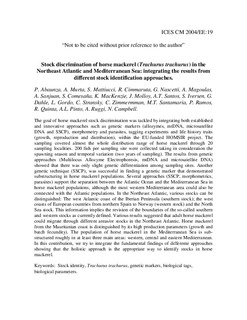Stock discrimination of horse mackerel (Trachurus trachurus) in the Northeast Atlantic and Mediterranean Sea: integrating the results from different stock identification approaches
Abaunza, Pablo; Murta, A.; Mattiucci, S.; Cimmaruta, R.; Nascetti, G.; Magoulas, A.; Sanjuan, A.; Comesaña, S.; MacKenzie, K.; Molloy, John; Santos, A.T.; Iversen, Svein A.; Dahle, Geir; Gordo, L.; Stransky, Christoph; Zimmermann, Christopher; Santamaria, M.T.; Ramos, P.; Quinta, R.; Pinto, A.L.; Ruggi, A.; Campbell, Neil
Working paper
Permanent lenke
http://hdl.handle.net/11250/106583Utgivelsesdato
2004Metadata
Vis full innførselSamlinger
Originalversjon
This report is not to be cited without prior reference to the General SecretarySammendrag
The goal of horse mackerel stock discrimination was tackled by integrating both established
and innovative approaches such as genetic markers (allozymes, mtDNA, microsatellite
DNA and SSCP), morphometry and parasites, tagging experiments and life history traits
(growth, reproduction and distribution), within the EU-funded HOMSIR project. The
sampling covered almost the whole distribution range of horse mackerel through 20
sampling localities. 200 fish per sampling site were collected taking in consideration the
spawning season and temporal variation (two years of sampling). The results from genetic
approaches (Multilocus Allozyme Electrophoresis, mtDNA and microsatellite DNA)
showed that there was only slight genetic differentiation among sampling sites. Another
genetic technique (SSCP), was successful in finding a genetic marker that demonstrated
substructuring in horse mackerel populations. Several approaches (SSCP, morphometrics,
parasites) support the separation between the Atlantic Ocean and the Mediterranean Sea in
horse mackerel populations, although the most western Mediterranean area could also be
connected with the Atlantic populations. In the Northeast Atlantic, various stocks can be
distinguished: The west Atlantic coast of the Iberian Peninsula (southern stock); the west
coasts of European countries from northern Spain to Norway (western stock) and the North
Sea stock. This information implies the revision of the boundaries of the so-called southern
and western stocks as currently defined. Various results suggested that adult horse mackerel
could migrate through different areas/or stocks in the Northeast Atlantic. Horse mackerel
from the Mauritanian coast is distinguished by its high production parameters (growth and
batch fecundity). The population of horse mackerel in the Mediterranean Sea is substructured
roughly in at least three main areas: western, central and eastern Mediterranean.
In this contribution, we try to integrate the fundamental findings of differente approaches
showing that the holistic approach is the appropriate way to identify stocks in horse
mackerel.
